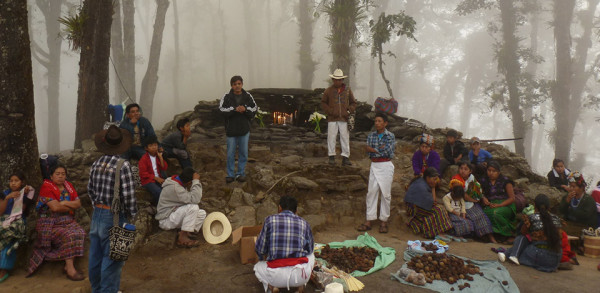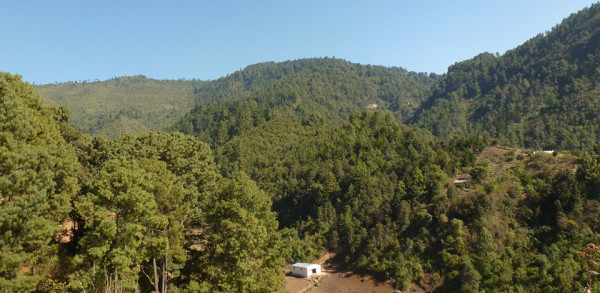
The Sacred Natural Sites Initiative and Oxlajuj Ajpop, the Guatemalan National Council of Mayan Spiritual Leaders are about to officially kick of a new project on sustainable forest management through recognition of cultural, spiritual and sacred values. Preparations for this project, supporting three rural Mayan communities in the Quiche district, have been long in the works and everyone is excited to see it succeed.
Oxlajuj Ajpop supports the communities to gain control over their sacred forests and helps them find ways for their management and co-management through dialogue and building bridges between the communities, the government and other stakeholders. Felipe Gomez, Mayan healer and spiritual leader with Oxlajuj Ajpop.

Ceremony held at the sacred natural site; “Chu Sqrib’al” located on top of the mountain which also hosts the communities “Rij Juyub’ y Buena Vista” part of the municipality “San Andres Sajcabaja” in the “Quiché” district. The sacred natural sites is of great spiritual and historic significance to the Maya as it is also mentioned in the “Popul Vuh”, one of the Mayas ancient spiritual scriptures. Source: Bas Verschuuren, 2012.
The project is supported by Hoja Verde, a Swiss Foundation promoting education and innovation for sustainable forestry whilst improving living conditions of local people. Within the project, Oxlajuj Ajpop and the SNSI are teaming up with several other partners organisations such as the COMPAS Network, the ICCA Consortium and Natural Justice. The later is also supporting the work on community protocols that is part of the focus of the project’s inception workshop to be held in Totonicapan, Guatemala, March 18-21. Read more bout the project, view earlier related news items, and watch videos on the dedicated project page.
The workshop will serve to bring the representatives of the three Quiche communities together for a visioning and planning exercise on the projects rather ambitious objectives. The project will develop over the course of one and a half years and aims to gain experience that wil last into the future. Together with Oxlajuj Ajpop and its partners the communities will develop:
– community protocols for the safekeeping of their sacred places and forests
– their own community action plans for forest and NRM management
– forest value indicators for forest stakeholders,
– dialogues about their forest values with forest related stakeholders,
– education materials on forests and NRM for schools,
– participatory videos for sharing with other communities and forest stakeholders
The community representatives will receive help from several national and international experts who have gained experience with developing community protocols and community conservation planning in various places in the world. Taking the community protocols as a starting point for the project is therefore a strategic choice. As the communities become aware of their rights and develop a common vision it is hoped that this will also be reflected in the NRM planning and the selection of cultural and spiritual forest value indicators to be developed for other forest stakeholders. In Guatemala forests are frequently used for ceremony, prayer and healing and are in cases regarded as sacred or holy. There is some recognition of cultural values in the sustainable forestry sector for example by the ITTOs, but this needs to be expanded.
One specific focus of the work is to elicit and promote community based indicators for the cultural, sacred and spiritual importance of forests through a series of dialogues ranging form the local to the national level. Bas Verschuuren, Coordinator for the Sacred Natural Sites Initiative.

Near Totonicapan several sacred natural sites are found in the community managed forests. The largest share of forests has been under community governance for over 300 years. Although pressures on the forest has gradually been increasing. In the photo, on the hill in the background you can see a privately owned forest on the left and the community forests, including important sacred natural sites, on the right. Source: Bas Verschuuren, 2012.
Read more bout the project, view earlier related news items, and watch videos on the dedicated project page.






